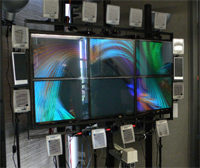Evolution of the Varrier™ Autostereoscopic VR Display: 2001-2007
January 28th, 2007
Categories: Devices, MS / PhD Thesis, Software, Visualization, VR

Authors
Peterka, T., Kooima, R., Girado, J., Ge, J., Sandin, D., DeFanti, T.About
Autostereoscopy (AS) is an increasingly valuable virtual reality (VR) display technology; indeed, the IS&T / SPIE Electronic Imaging Conference has seen rapid growth in the number and scope of AS papers in recent years. The first Varrier paper appeared at SPIE in 2001, and much has changed since then. What began as a single-panel prototype has grown to a full scale VR autostereo display system, with a variety of form factors, features, and options. Varrier is a barrier strip AS display system that qualifies as a true VR display, offering a head-tracked ortho-stereo first person interactive VR experience without the need for glasses or other gear to be worn by the user.
Since Varrier’s inception, new algorithmic and systemic developments have produced performance and quality improvements. Visual acuity has increased by a factor of 1.4X with new fine-resolution barrier strip linescreens and computational algorithms that support variable sub-pixel resolutions. Performance has improved by a factor of 3X using a new GPU shader-based sub-pixel algorithm that accomplishes in one pass what previously required three passes. The Varrier modulation algorithm that began as a computationally expensive task is now no more costly than conventional stereoscopic rendering. Interactive rendering rates of 60 Hz are now possible in Varrier for complex scene geometry on the order of 100K vertices, and performance is GPU bound, hence it is expected to continue improving with graphics card enhancements.
Head tracking is accomplished with a neural network camera-based tracking system developed at EVL for Varrier. Multiple cameras capture subjects at 120 Hz and the neural network recognizes known faces from a database and tracks them in 3D space. New faces are trained and added to the database in a matter of minutes, and accuracy is comparable to commercially available tracking systems.
Varrier supports a variety of VR applications, including visualization of polygonal, ray traced, and volume rendered data. Both AS movie playback of pre-rendered stereo frames and interactive manipulation of 3D models are supported. Local as well as distributed computation is employed in various applications. Long-distance collaboration has been demonstrated with AS teleconferencing in Varrier. A variety of application domains such as art, medicine, and science have been exhibited, and Varrier exists in a variety of form factors from large tiled installations to smaller desktop forms to fit a variety of space and budget constraints.
Newest developments include the use of a dynamic parallax barrier that affords features that were inconceivable with a static barrier.
Keywords: Varrier, autostereoscopic 3D display, virtual reality, camera-based tracking, parallax barrier
Resources
Citation
Peterka, T., Kooima, R., Girado, J., Ge, J., Sandin, D., DeFanti, T., Evolution of the Varrier™ Autostereoscopic VR Display: 2001-2007, IS&T / SPIE Electronic Imaging 2007 Conference Proceedings, January 28th, 2007.